Imagine a creature so peculiar, it almost seems like a character from a children’s storybook—yet it exists, high in the emerald canopies and winding mangroves of Borneo. With their comically oversized noses, potbellied frames, and flamboyant leaps from tree to tree, proboscis monkeys capture both laughter and awe. But beneath their clownish charm lies a somber reality: these remarkable primates teeter dangerously close to oblivion. Their survival story is filled with drama, beauty, and the urgent ticking of time.
The Remarkable Appearance of the Proboscis Monkey

Proboscis monkeys are instantly recognizable, thanks to their shockingly large noses, which dangle dramatically from the faces of adult males. This iconic feature isn’t just for show—it’s believed to amplify their calls, helping them communicate across the dense forests. Males sometimes have noses so big, they hang over their mouths, leading to exaggerated snorts and honks that echo through the jungle. Females and juveniles sport smaller, upturned noses, adding to the quirky family portrait. Their reddish-brown coats, cream-colored bellies, and long, spindly limbs make them look perpetually out of place, as if designed by a playful artist.
Masters of the Mangroves

These monkeys are true specialists, living almost exclusively along rivers, swamps, and coastal mangroves of Borneo. Their habitats are a tangle of roots and branches, flooded by tides and teeming with life. Unlike most primates, proboscis monkeys are superb swimmers, often plunging into the water to escape predators or travel between food sources. Webbed feet and hands set them apart, allowing for powerful strokes through muddy currents. For the proboscis monkey, the mangrove maze is both playground and sanctuary—a place few other large mammals dare to call home.
Social Lives Full of Drama and Laughter

Proboscis monkeys live in tight-knit groups, each led by a dominant male surrounded by several females and their young. These bands are social hotspots where grooming, play, and squabbles unfold daily. Males perform loud, theatrical displays to assert dominance or attract mates—sometimes using their noses like trumpets. Youngsters leap and tumble, practicing acrobatics on springy branches, while mothers keep a watchful eye. This complex social structure helps the group coordinate movements, share food, and defend against threats, weaving a web of relationships as intricate as the forest itself.
Unusual Diets for Unusual Monkeys

Unlike many primates that feast on fruits, proboscis monkeys are selective eaters, favoring young leaves, shoots, and seeds. Their diet is tough and fibrous, requiring a specialized stomach filled with bacteria to break down toxins and extract nutrients. This digestive system is so effective, it allows them to survive on plants that would sicken other animals. However, their pickiness also makes them vulnerable—if their favorite trees disappear, so does their food. Sometimes, they supplement their diet with unripe fruits and even occasional insects, showing adaptability, but always within a narrow range.
The Role of the Nose: More Than Just a Funny Face
The oversized nose of the proboscis monkey is more than a visual oddity—it’s a crucial tool for survival. Scientists believe the nose acts as a resonator, deepening the male’s call and making it travel farther. This booming voice can deter rivals and attract mates, signaling strength and maturity. Some researchers think the nose also plays a role in cooling the monkey as it breathes, or even in mate selection, with females preferring the most impressive noses. In a sense, the nose is both a badge of honor and a love song, passed down through generations.
Life in a Threatened Paradise

The lush mangroves and riverbanks of Borneo have been shrinking, sliced away by logging, oil palm plantations, and expanding human settlements. This relentless deforestation is a slow-motion disaster for proboscis monkeys, who depend on dense, undisturbed forests. As their world shrinks, they are forced into smaller and more isolated groups, making it harder to find food, mates, and safety. The loss of habitat is often invisible to outsiders, but for the monkeys, every felled tree is a blow to their future.
Predators, Perils, and Survival Tactics
Proboscis monkeys face dangers both natural and man-made. Crocodiles lurk in muddy rivers, while clouded leopards and pythons stalk the shadows. To escape, the monkeys rely on their swimming skills and keen senses. They often sleep high in trees near water, ready to leap in at the first sign of trouble. But their greatest threat is still human activity—poaching, habitat destruction, and even illegal pet trade. Survival means constant vigilance, adaptability, and the ability to navigate a world that grows more treacherous by the day.
A Symphony of Sounds in the Jungle

The forests where proboscis monkeys live are alive with sound, much of it made by the monkeys themselves. Males bellow and honk to declare territory, warn of danger, or woo potential mates. These calls can be heard over long distances, especially at dawn and dusk, when the jungle comes alive. Females and young monkeys use softer grunts, squeaks, and even laughter-like calls during play. This chorus of noise is vital for keeping groups together and alerting others to news—good or bad—rippling through the forest.
Conservation Efforts: Racing Against Time
Efforts to protect proboscis monkeys are underway, but the race is tight. Conservationists work to preserve mangroves, restore degraded forests, and educate local communities about the monkeys’ importance. Eco-tourism initiatives bring visitors to see these charismatic animals, creating economic incentives to protect habitats. Laws and protected areas offer some hope, but enforcement can be weak, and progress is slow. Every new sapling planted, every riverbank restored, is a small victory for the monkeys—but the challenges remain immense.
Why Proboscis Monkeys Matter
Beyond their comic appearance, proboscis monkeys are vital to the ecosystems they inhabit. As seed dispersers, they help maintain the health and diversity of forests. Their presence signals a thriving, balanced environment, where water, trees, and wildlife co-exist in delicate harmony. Losing them would mean more than the end of a species—it would unravel the fabric of Borneo’s unique coastal wilderness. They are ambassadors for a hidden world, reminding us of nature’s wonder and fragility.
Hope for the Coastal Clowns

Despite the daunting odds, there is hope for the proboscis monkey. Their resilience is inspiring: they adapt, learn, and persevere in the face of adversity. People across Borneo are beginning to see their value, not just as a tourist attraction, but as a symbol of pride and stewardship. Schools teach children about their “nosey” neighbors, and local heroes fight to reclaim lost forests. Each small act, each voice raised in their defense, brings the proboscis monkey one step closer to a future where laughter still echoes through the mangroves.



